1980s sports car icons Porsche 928 S4 vs. 944 S2
This year, the 928 celebrates its forty-fifth anniversary. At the same time, its smaller-engined stablemate, the 944, reaches its fortieth birthday. We hit the open roads of the Staffordshire Moorlands for a play with two 1980s sports car icons: the 928 S4 and the 944 S2… Words Dan Furr and Richard Gooding. Photography Dan Sherwood.
DOUBLE ACT
BACK TO THE EIGHTIES
MODERN CLASSICS FROM THE DECADE OF EXCESS
The 928 S4 takes on the 944 S2. It’s hard to imagine Porsche without the 911, but in the late 1970s and early 1980s, it seemed a distinct possibility. A layout seen by many as increasingly dated, not to mention cramped rear seats and technical limitations dictated by the two-door’s technical make-up, encouraged those inhabiting corridors in Zuffenhausen to think about a new flagship Porsche product.
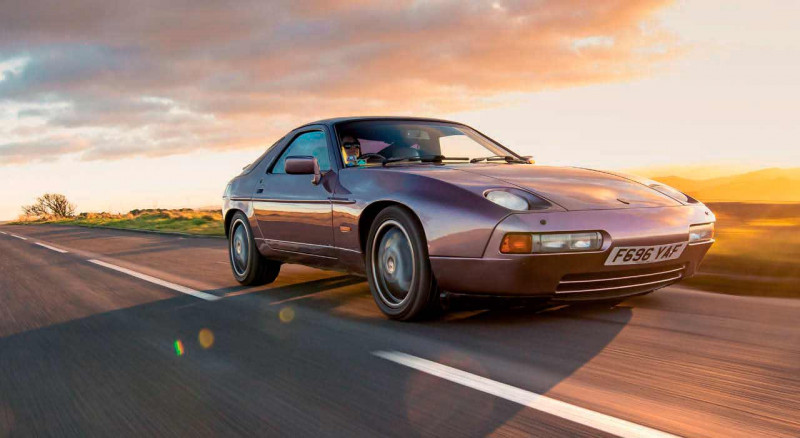
Company chairman, Ernst Fuhrmann (designer of the famous Type 547 flat-four), envisaged a more capable 2+2 in the form of a grand tourer capable of massive mile munching. This was no reimagining of the 911 — the resulting 928 was a ‘clean sheet’ design and one which set Porsche’s technological beacon shining once again.
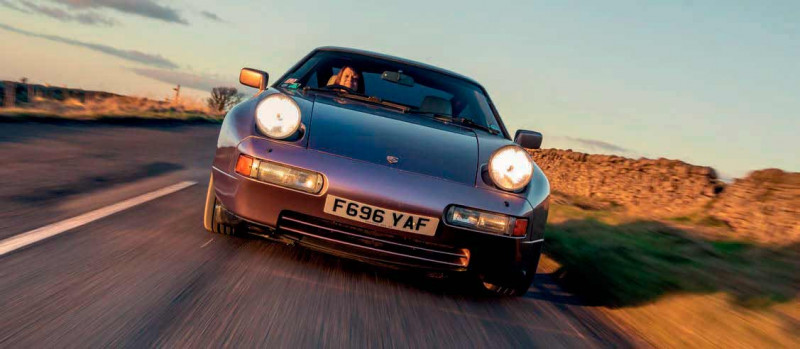
NO MATTER THE CONDITION OF 944 S2, IT’S A MORE CONSPICUOUS SIGHT ON 2022’S ROADS THAN AN AIR-COOLED 911
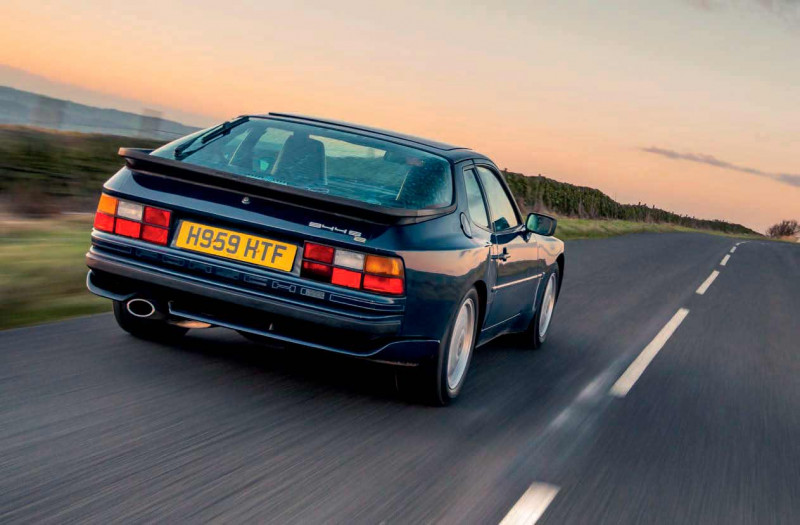
Work began in earnest as soon as the project was given the green light. In fact, as early as 1971, factory engineers and draughtsmen began to conceptualise the all-new Porsche. Decreed to be a car in the long-legged gran turismo mould, the 928 would pack the luxury of a high-end sedan with the style and performance of a true sports coupé. Powerplant and transmission packaging issues ruled out a repeat of the rear-engine format, which promised to play havoc with emissions — a complaint Porsche was trying to address with thePorsche 911 — in the face of ever-stricter highway safety legislation in the United States. Fuhrmann’s team was also concerned about rumours concerning a proposed ban on rear-engined cars in North America.
TWO BASE-MODEL 924s BEING TRANSFORMED INTO 924 CARRERA GT LOOKALIKES, A 924 S, A LATE 944 TURBO AND AN EARLY 944 TURBO S
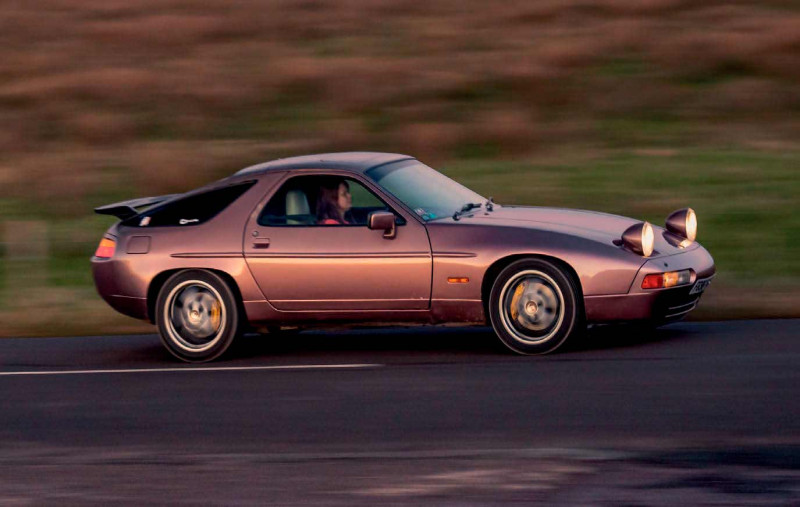
Discussions regarding a mid-engine configuration ended swiftly, largely because the 928’s cabin space would be severely compromised. This left a front-engined, rear-wheel drive setup as the preferred and obvious solution. From the get-go, a big engine was planned for thePorsche 928. Prototypes were built using a five-litre V8, although Ferdinand Piëch (engineering mastermind behind Porsche’s motorsport programme in the 1960s and, later, chairman of the board at Volkswagen) argued the case for a 4.6-litre V10 envisaged as resulting from a programme of modifying Audi inline-fives. Much to his anger, he was outvoted by colleagues occupying seats on the Porsche board — the 928 would land in dealer showrooms with a Porsche-penned 4.5-litre V8 sitting beneath its long bonnet.
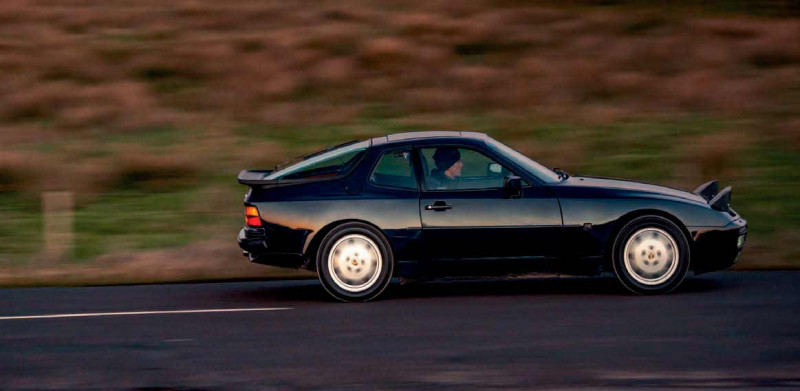
The covers were pulled off the new car at the 1977 Geneva Motor Show.
Compared to previous Porsches (even the four-cylinder 924, which leapfrogged the 928’s launch due to the two global oil crises of the mid-1970s calling a temporary halt on the bigger-engined car’s development), Wolfgang Mobius’s design looked as though it had arrived on Earth from another planet. The gorgeously curved design and bulbous rear end hinted at the mechanical layout within, while the model’s exposed pop-up headlights were celebrated for aiding aerodynamic efficiency when retracted. Integrated polyurethane bumpers also helped Porsche’s new GT slip through the air. These design features combined to give the car its ‘land shark’ nickname. Impressively, the bonnet, doors, and front wings were made from aluminium and were bolted to a galvanised shell. Other features included a practical rear hatchback, ideal for carting plenty of luggage across the continent. Also, the 928 was the first car to boast an instrument binnacle which moved in tandem with the adjustable steering column for maximum visibility. Distinctive fifteen-inch ‘teledial’ alloys helped the new Porsche become an instant style icon. Sixteen-inchers were available as an optional extra.
The 928’s M28-09/10 beating heart produced 240bhp (219bhp in America thanks to a detuned version of the engine, labelled M28-15/16) and was a single overhead camshaft design loaded with mechanical fuel injection. As was de riguer with new Porsches at the time, the 928’s fearsome lump ditched air cooling — the water-cooled unit transferred its power to the road via a transaxle to the rear-mounted gearbox. This was the first time in Europe an engine boasted etched cast aluminium cylinder linings, and the low compression rating of 8.5:1 allowed the 928 to run happily on 91 RON petrol.
FLEXING MUSCLE
Engineering wizardry was the order of the day. The M28’s bore spacing of 122mm was almost the same as that of the Chrysler 426 ‘Hemi’ or Chevrolet big block. Spark plugs mounted on top of the cylinder head aided airflow under a low bonnet line, while four-bolt bearings were fed by oil grooves in the bottom surface of the aluminium block.
Both oil and water pumps were driven by the timing belt. As you might expect from a grand tourer, the vast majority (close to eighty percent) of all 928s produced were kitted-out with automatic transmission, namely a three-speed unit borrowed from Mercedes-Benz. A five-speed dog-leg manual gearbox was offered as an option, allowing drivers to manage their new Porsche’s 268lb-ft torque in a manner more in keeping with what they may have been used to in their somewhat dated 911s.
Among a long list of plus points, the 928’s crowning glory is its Weissach rear axle. Specially developed for the 928, the rear-wheel steering system was designed to eliminate lift-off oversteer, a trait 911 owners had complained about for years. The bigger Porsche’s rear suspension adjusted itself during cornering with such success that a passive rear-wheel steering system (of sorts) eventually found its way onto the 911, with both the 964 and 993 implementing innovations mirroring the Weissach effect. The 928 also featured a power steering system using an engine-driven hydraulic pump, reducing assistance at high revs to firm-up steering feel when drivers fancied travelling at high speed.
These technical marvels set the contemporary pace. In 1978, the 928 was named European Car of the Year, beating off its BMW 7 Series and Ford Granada rivals. To this day, the 928 is the only sports car to win the gong. It rewarded Porsche’s engineers for a job well done and firmly placed the brand’s grand tourer on the automotive map.
Porsche purists, however, were less than impressed. Reluctant to embrace the company’s transaxle family of cars due to them being such a radical departure from the DNA of the 911, visitors to Porsche main dealer showrooms were slow to place orders. What they failed to realise was that thanks to a perfect 50/50 front/rear weight distribution and the aforementioned diet-led body, the 928’s neutral balance and higher engine output gave the 911 a run for its money in the performance stakes. Indeed, it took the 928 just eight seconds to reach 60mph from a standing start, romping on to a top speed of 142mph. Add the grand tourer’s luxury, comfort and long-distance cruising abilities, and it’s difficult to see what’s not to like.
Better still, the 4.7-litre 928 S was good for almost 300bhp when launched for the 1980 model year. The car’s chunky front splitter and equally prominent rear spoiler enhanced the pure lines of the original 928’s shape, delivering a more aggressive stance. Larger brakes helped to halt the extra pace. Stateside buyers had to wait until 1983 before they could get their hands on an S, but a ‘Competition Package’ allowed owners in America to turn their clean cars into S lookalikes through the application of the Euro-spec spoilers and the Corvette-aping, sixteen-inch flat-disc alloy wheels fitted to the 928 S back in Zuffenhausen.
Sports seats, lowering springs and Bilstein dampers also formed part of the popular kit.
Predictably, when the 928 S eventually made its way across The Pond (coinciding with all 4.5-litre 928s being dropped), power was down. 230bhp was all cars destined for the US domestic market were blessed with.
Even so, Porsche proudly proclaimed the S as “the fastest street-legal production car sold in the USA”. Ironically, just as the model landed in the land of stars and stripes, European markets welcomed an even pokier 928 in the form of the near 310bhp S2, bringing Bosch LH-Jetronic fuel injection to proceedings, while ABS made its debut on a Porsche. America soon caught up, though — a new, five-litre, thirty-two-valve double overhead cam M28 V8 was introduced to the USA in 1985, with the model it powered unofficially referred to as the 928 S3. Though seats and door cards were updated to a newer, more avantgarde style, the car remained virtually indistinguishable from the sixteen-valve 928 it superseded. 288bhp was less than European drivers were used to, but this power was a significant jump up from earlier 928s sold in US dealer showrooms. A top speed of 155mph was quoted in sales brochures.
GIVE ME FIVE
As the excessively excessed ‘eighties passed their halfway point, the last of the original-body 928s rolled off the production line. Revised suspension, twin-circuit servo-assisted four-pot stoppers and a new exhaust were added to the final examples of the old guard, and it’s these cars which are considered by many to be the 928’s sweet spot, often referred to as the 928 S2-and-a-half, benefiting from power and specification not wildly removed from what came later, but without the complexity of the thirty-two- valve engine, which was revised with updated pistons, cylinder heads, camshafts and a revised valvetrain for the arrival of the 928 S4 in 1987. This time, the suffix was an official model name. Now producing close to 320bhp, the five-litre engine propelled a Porsche with significantly revised exterior styling, including smoother bumpers, an incorporated front splitter, near flush wide rear light clusters and a defiantly obvious ‘ironing board’ rear spoiler. The more aerodynamic lines may have cut drag by an impressive thirteen percent, but, mercifully, Mobius’ overall design was left largely intact.
The 928 S4 is what we see here. Dressed in Cassis Red — one of those Porsche ‘reds’ everyone agrees is actually pink — it’s the pride and joy of Stefanie Mahan, one of the regional organisers for the Cheshire and Staffordshire region of The Independent Porsche Enthusiasts Club (TIPEC). It’s a role she performs with her partner, Gareth Aldridge, the owner of the 944 S2 sparring with the V8 across these pages. Despite sharing a 996 Carrera 4S Cabriolet loaded with almost fifty grand’s worth of factory cost options, not to mention Gareth being raised on a diet of air-cooled 911s (courtesy of Porsche-owning parents whose blood must have its own octane rating), they find themselves returning to the water-cooled, front-engined, rear-driven models in the manufacturer’s back catalogue time and again. So much so, Gareth’s spacious workshop — he’s a carpenter by trade — plays host to an intriguing array of transaxle models in various states of repair. Among the collection are two base-model 924s being transformed into 924 Carrera GT lookalikes, a 924 S, a late 944 Turbo and what many consider the most desirable of 944 road cars: an early 944 Turbo S, often referred to as Silver Rose on account of the official name for the model’s distinctive metallic silver paintwork, as well as its wealth of burgundy plaid cloth. Later, the Turbo S would become available in any colour and with any interior, eventually losing the S suffix and becoming the standard 944 Turbo offering, but for collectors and many enthusiasts alike, the 1988 Silver Rose offers unrivalled 944 exclusivity.
STATE OF THE UNION
It’s a car Gareth has owned for many years and, in partnership with nearby independent marque specialist, MLR Porsche, is currently being fully restored in preparation for its intended role as his and Stef’s wedding car. More silver than rose right now, the force-fed transaxle has been stripped back to a bare shell following an acid dip at Dudley-based metal decontamination specialist, Surface Processing, in readiness for new sills and whatever else the monocoque needs prior to reassembly. But why, with a highly desirable 911 at their disposal, do this pair of petrolheads get such a kick out of Porsche’s transaxle family of cars? Gareth doesn’t mind admitting his intention was to follow in the footsteps of his parents and hop into an air-cooled Porsche, but by the time he could afford to do so (at the age of twenty-five), insurance costs proved too expensive.
Reasoning a 924 or 944 would scratch his itch for a Stuttgart-crested sports car until cost of 911 ownership became more agreeable, he bought a 924 S — essentially a 924 with a toned-down 2.5-litre 944 powerplant. A desire for more grunt encouraged him to consider changing-up for a 944 S2 or Turbo, at which point he found the Silver Rose. Tired but fully functional, it was a decisive purchase. “The drive home cured me of my desire for ownership of an air-cooled 911,” he tells us. “I was bowled over by a hugely entertaining behind-the-wheel experience. A 944 Turbo, S-badge or otherwise, is a very quick car, even in modern traffic. I immediately knew this was everything I could want from a Porsche.”
Even so, we’re talking about 1980s forced induction technology, which often means big turbo lag before a huge and sudden punch of boost. It’s a characteristic often associated with the 911 Turbo (930), which, through the appointment of an impressively quick engine and lightweight construction, delivered big bursts of boost — in collaboration with a tail-happy rear end and a nose prone to lift — to earn the model its reputation as ‘widowmaker’.
Of course, the 944 Turbo was released more than a decade later and offered buyers near equal front-rear weight distribution, but lag was still a feature of turbocharged Porsches and can catch any driver unaware if they’ve not yet encountered the sensation of being punched in the back and suddenly propelled forward after a few seconds being lulled into a false sense of security. Nothing happens, then… bam!
Enhanced by a Chipwizards ECU update and fuel equipment upgrades to the tune of 327bhp, Gareth’s Silver Rose was particularly aggressive before its retirement from the road. Though Stef learned how to manage the sudden onslaught of power, she tells us she’s far more at home in a normally aspirated Porsche from the era, hence her love for the same-age 928 S4 she fondly refers to as Cassie, bought on Valentine’s Day 2016 and — contributing to something of a developing theme — subsequently used as her cousin’s wedding car.
Like many owners of products from Porsche’s transaxle family, Gareth enjoys spannering his car’s engines. We suggest the thirty-two-valve version of the M28 V8 is significantly more difficult (and expensive) to work on than any of the four-cylinder water-cooled Porsche engines of the era. “The early 944 is a great car for home mechanics to cut their teeth on, but subsequent evolutions of the four-cylinder and eight-cylinder transaxle line introduce a huge amount of complexity under their bonnets,” he tells us. “The 944 is definitely simpler to work on than one of these,” he continues, lifting the hood of Stef’s S4. “There’s more room to work around the engine bay and virtually everything is simpler in design, but you have to remember the M28 V8 was a masterpiece of Porsche engineering. That’s not to throw shade on the 944’s inline-four, but the V8 is far from an engine for the feint-hearted. Put it this way, without the wealth of help and information available from online technical guides and advice from fellow enthusiasts, including TIPEC members, I would have found working on this engine very difficult.”
To our surprise, considering how poor 928 parts availability is when compared to that of the 944 — a fact which explains why the top floor of Gareth’s workshop is an Aladdin’s Cave of 928 parts stripped from the many donor vehicles he’s despatched over the years — he tells us he prefers working on the M28 to the 944 Turbo’s boosted M44 engine, which he cites as frustratingly complicated thanks to the array of forced induction paraphernalia occupying the model’s front end. Ultimately, it’s the normally aspirated four-cylinder 944 engine which he finds most rewarding, offering straightforward mechanicals, even in three-litre S2 guise. As we’ve touched on elsewhere in this magazine, the S2’s beating heart — featuring dual overhead camshafts, sixteen valves, a 104mm bore and 88mm stroke for 2,990cc swept capacity — was the world’s largest four-cylinder production engine, affording the S2 208bhp and 206lb-ft torque (the latter available at 4,100rpm), only marginally less than the original 944 Turbo of 1985, but with a linear delivery of power.
Out on the deserted roads of the Staffordshire Moorlands, Gareth’s blue S2 cuts a fine figure alongside Stef’s much larger 928 S4. Dressed in the Turbo body kit afforded to the S2 on launch for the 1989 model year, the 944 looks modern even by today’s standards, testament to the excellent work of Harm Lagaaij’s design team when developing the 944 Turbo more than half a decade earlier. The original Turbo is more than a second quicker than the S2 when sprinting to 60mph, but with the normally aspirated Porsche’s revised gearing (to better suit the three-litre engine) and a top speed of 150mph, the slower pace is barely noticeable, even out here, where tight, exciting twisties demand you consider stopping distances as keenly as how determined you are to work your way through the rev range. The Design 90 sixteen-inch cast alloys are standard S2 equipment, completing the 944 facelift Lagaaij was charged with delivering in readiness for the 1990s, and though the icing on the cake would be the cost-option limited-slip differential and uprated suspension ordered by many original buyers, the S2 handles brilliantly in standard trim.
As was the case with the original 944 Turbo, the S2’s ‘oval dash’ is a masterpiece of ergonomic design, with everything laid out clearly and precisely where you need or expect it to be. In fact, on the whole, the S2 interior is excellent, more so if optioned with big-bolstered Sports seats, keeping you firmly in place as you throw the car into bends. In addition to being comfortable, the S2 is also an easy car to drive (free of the somewhat unnerving jolt of the 944 Turbo’s sudden boost), making it the perfect entry point for those with limited experience of performance cars looking to secure Porsche ownership on a modest budget. On this point, for those not wanting to spend 911 money, the S2 is a solid buy and, providing the usually robust M44/41 inline-four has been well maintained with regular fluid and filter changes, and if belts and tensioners are changed in accordance with the manufacturer’s recommended service intervals, even high-mileage examples should provide years of mechanically sound motoring.
It should be noted, the timing belt drives only the exhaust camshaft. The inlet camshaft is driven by a chain linked to the exhaust camshaft. Chains can wear, but problems are usually identified as the supporting plastic tensioner becoming brittle with age, resulting in cracks and causing the chain to slip free. The damage is much the same as if the belt snapped, which is why you should change the chain and tensioner at belt intervals, just to be on the safe side. Cars without this work being done could be living on borrowed time. There’s also a toothed belt running between the balance shafts and the crankshaft. It’s another serviceable component. Failure will encourage the engine to run lumpy, which is why it’s worth changing all belts at the same time.
Porsche reckons the 944 S2 is the “most exciting in the model series” and cites production of fewer than 9,400 coupes and 7,000 Cabriolets — the S2 introduced the first 944 drop-top — as reason enough to pick the three-litre model above all others. It’s certainly one of the best-value used Porsches available right now, with well-presented examples commanding between ten and fifteen grand. Of course, cars in need of attention can be bought for much less, but no matter the condition of S2, it’s a more conspicuous sight on 2022’s roads than an air-cooled 911. Add a 928 S4 to the mix and you’ve got a nothing short of a feast for the eyes.
Stepping into Stef’s car, you’re immediately taken with how much bigger everything feels. Wider, longer, the ability to comfortably house two passengers in the back. Yes, it’s a Porsche, but this isn’t cut from the same cloth as the 944. Shared incidental interior trim (headlight switch, instrument stalks) hint at one of Porsche’s only attempts to share components across its period product range — a hugely cost inefficient manufacturing trait eliminated with the 986 Boxster and 996-generation 911’s shared assembly lines — but this is a very different Stuttgart-crested sports car.
WEISSACH WONDER
The V8 is silky smooth, producing a distinct, comforting purr, even when provoked with an eager right foot. Pulling away, it’s obvious this is a heavy Porsche, but high speed is reached rapidly. Handling is much softer than the 944, and though the nimbler, smaller-engined Porsche is happier to be thrown into corners at speed, the effect of the 928’s Weissach rear axle can be felt when trying the same. It doesn’t make the car any quicker in curves, but it makes what many consider a large Porsche much easier to handle and far more predictable. We’ve talked about the technology before, but it’s essentially a short extra control link between the lower wishbone and the body-mounted rubber bushing, plus a few tweaks to the placement of the mounting points on the body. You’d barely notice this in a photograph of the suspension, making it all the more elegant. Under braking and deceleration, the extra pivot causes a little toe-in at the rear wheels, and the strength of this effect can be minutely adjusted by the length of the control link, along with the geometry of the rest of the wishbone and its mounting, thereby eliminating oversteer. The sophistication of Porsche’s latest self-steering systems may be a world away from the early Weissach axle implementation, but the principles remain unchanged — the enjoyment of driving a Porsche may never have been brought to so many people if it wasn’t for the ingenuity of engineers working on the 928.
CLUB TOGETHER
An S4 Cabriolet prototype was created by Porsche, but with 928 sales remaining difficult, the project was canned.
Zuffenhausen’s answer to showroom visitors not being convinced by the grand tourer’s sports car credentials was to launch the 928 Club Sport (CS), a variant tipping scales 100kg earlier than the S4. The Special Equipment (SE) was also ushered in, an attempt to satisfy drivers who wanted less refinement than what was being offered by the S4, but not quite the level of aggression promised by the CS. The SE was a UK-only experiment and is sometimes referred to in print as the 928 Sport (not confusing at all, then?!). Only forty-two examples were built — a low number, but one towering over the CS’s production volume of just seventeen units.
The end of the decade saw the 928 make a concession to the increasingly digital age with the introduction of a funky trip computer. Another aptly named variant, the 928 GT, debuted in 1989. Replacing both the short-lived CS and SE, the new 326bhp 928 was more in keeping with the SE, a fact highlighted by use of a ZF forty percent limited-slip differential. Just like the CS and SE, the GT was only offered with manual transmission. Technology from other Porsches was carried over, too. For example, the 959 supercar’s tyre pressure monitoring system and a zero-to-hundred percent Porsche Sperr Differential (PSD) variable ratio limited-slipper was fitted in 1990, the same year the stick-shift S4 was discontinued.
The five-litre land shark expired with the GTS, a 5.4-litre final incarnation of the 928 introduced for the 1992 model year. It was the only 928 on sale until model discontinuation in 1995, some eighteen years after the original 4.5-litre 928 was released into the wild. The cost of owning a GT or GTS has tipped into the fifty grand mark in recent years, making the S4 an extremely tempting proposition. On-the-road examples are currently available from £12,000, matching the 944 S2’s price point.
At Porsche, the 928 was seen as a likely antidote to falling 911 sales. Moreover, development of the model was deemed to be an accidental stroke of good fortune when US legislators announced their intention to evaluate whether rear-engined cars should be banned from being sold in America. Of course, the ban failed to materialise, but so did Ernst Fuhrmann’s expected rush of 928 sales — little more than 61,000 928s were assembled. Just 4,300 of those were sold in the UK, meaning the 928 is hardly the most prolific of Porsches. That said, it paved the way for our favourite manufacturer’s modern line of large sports cars, not least the Panamera.
Today, the 928’s effortless power, practicality and still-futuristic looks have earned it a die-hard following of loyal enthusiasts, but opulence and gran turismo gait don’t come cheap — the days of easily finding a bargain 928 in good order are long gone. Thankfully, there are still reasonable deals to be had. All you need to do is decide if you want to harpoon yourself a legendary land shark or hold out for its four-cylinder 944 S2 stablemate. Decisions, decisions…
Above The 928 was Porsche’s first V8-equipped model and remains the only Porsche coupe powered by a front-mounted eight-banger. Above One of the two 924 Carrera GT replica builds in Gareth’s personal Porsche playground Below Pop-up headlamps are a feature of all Porsche transaxle models, though later model 928s and the 968 make use of always exposed lamps.
Above In addition to an increase in engine capacity to improve delivery of power, 944 S2 was treated to 944 Turbo styling. Above Cassis Red is rarely seen, but it’s a fantastic OEM colour which takes years off the Porsche it covers Below A sea of 924, 928 and 944 spares share space with the cars undergoing work.
Above Early 944 Turbo S shell has been acid-dipped in preparation of the car’s full restoration Below 944 S2 remains sensibly priced and is a great Porsche to live with as a daily drive
Above Weissach rear axle makes a big difference to the 928’s handling. Above S4 styling went some way toward Porsche achieving a common(ish) look for its products in period. Below Gareth’s carpentry workshop is home to a variety of 924 and 944 projects.

